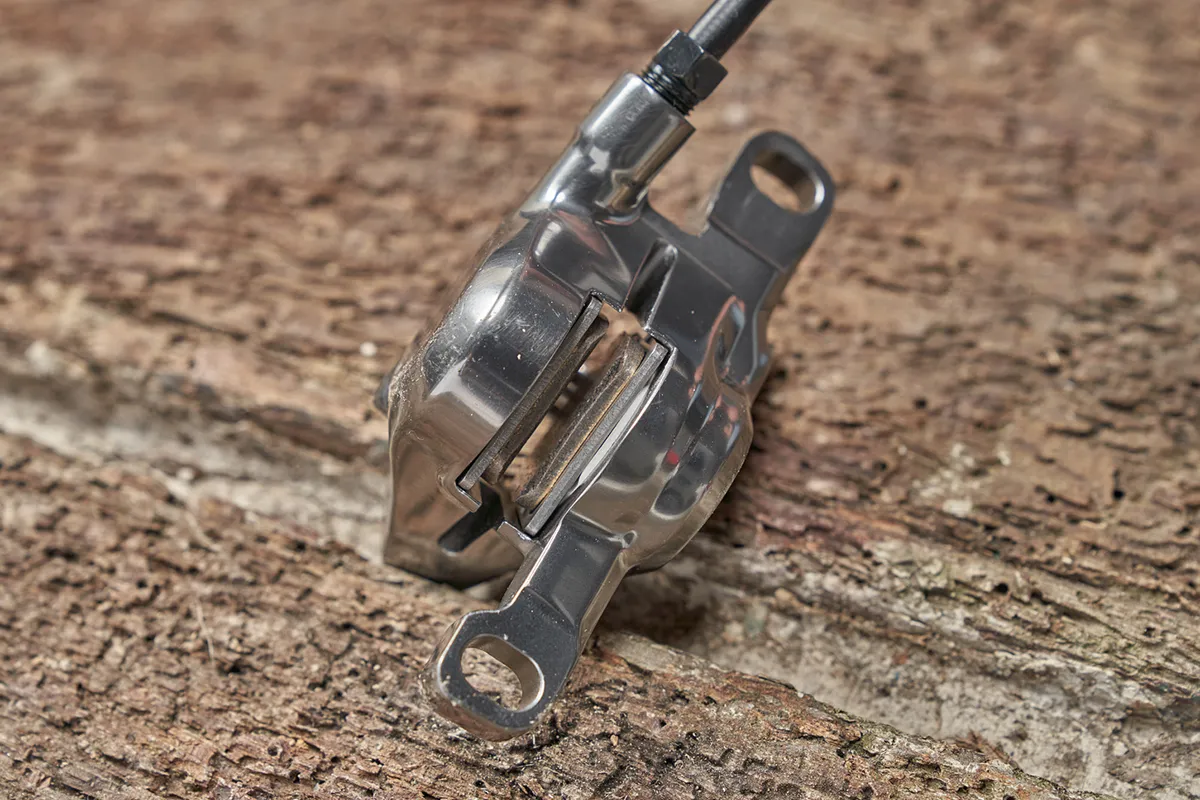Shimano’s race-ready XC brake packs two pistons into a lightweight package, which has fewer features than heavier trail-orientated brakes.
In order to save weight, the carbon lever body has tooled reach adjust (rather than tool-free), and there’s no free-stroke (or bite-point) adjustment either.
Shimano XTR M9100 specification

The levers feature Shimano’s signature mid-length, curled-up-at-the-end, lever blade shape. It has proved reliable and comfortable for years now. It’s built from a carbon composite to shave weight, and comes with a textured finish towards the end to improve finger or glove grip.
Reach adjustment is done via a grub screw located between lever blade and bar – it’s not the easiest to get to, but offers a good range of lever positioning. Be aware that towards its inner-most position, the blade may hit the grip before full power is reached.
The reservoir sits nearly parallel to the bar. Often, this can relate to excess lever-body flex when really pulling on the lever. However, Shimano’s unique bar brace, sat between bar and pivot, completely eliminates lever-body flex, contributing towards Shimano’s signature bite.
This results in a compromise that dropper lever and SRAM shifter compatibility is potentially trickier, though the I-Spec lever mounts can be adapted to many third-party levers and shifters.
Shimano uses a split clamp, with a top-loading 4mm Allen bolt, which has a rubber ring holding it captive.

In use, it’s more fiddly than other split-clamp designs, with a vague insertion angle of the bolt causing frustration.
The clamp also requires the insertion of a small pin or 1.5mm Allen key to unlock the clamp. I’m yet to work out what advantage this offers over a free-to-open clamp.
At the single-piece, magnesium-forged caliper end, there are two ceramic pistons pushing on the stock sintered pad. These pistons are said to be light, and resist heat build-up.
The hose exit is fixed, rather than banjoed, and the Shimano bleed procedure can be tricky to follow from the paper instructions (online guides are easier).
Shimano XTR M9100 performance

Fitting Shimano’s brakes straight from the box is easy. Brakes come without the hose attached, but all the required barbs and olives are in place already.
This means you just need to remove the brake lever’s bung and push the hose into its entry, before securing with an 8mm spanner.
With a little care, it’s easy to attach the hose (after routing it through the frame – the big benefit of hoses arriving unattached) without needing to bleed the brake.
The bedding-in process wasn’t the fastest I’ve experienced, though once complete, Shimano’s customary ‘digital’ lever feel was present – perhaps a touch less punchy than its four-piston stoppers, though. This means the initial bite is strong, with much of the brake’s power being delivered early in the stroke.
Less lever travel is required than on some brakes to find full power, and I found that achieving full power didn’t require a real hard pull on the bars.
The lever action is nice and light, and doesn’t feel heavily sprung in its return.
This leads some to say that they have little modulation, however the power is still easy to control with a nuanced application of lever pull.
Overall power levels are reasonable, rather than exceptional. However, it’s worth bearing in mind that these are XC race-focused brakes, so all-out power might not be the main consideration. Their low weight makes them stand out, though.
Shimano XTR M9100 bottom line

Popular for a reason, these Japanese stoppers perform admirably in a broad range of XC situations.
Shimano’s levers are some of the best in the business, though adding free-stroke adjustment to these race-bred levers would elevate their score a touch.
You can find more power in an XC brake if you look for it, but in my opinion, the lever feel, construction and weight all add up to make this one of the best XC brakes on the market.
How we tested
This year, our expert reviewers have tested a selection of the best mountain bike brakes, split into two broad genres.
First, there’s a selection of the most powerful stoppers, aimed at downhill, enduro and electric mountain bike riders. We’ve kitted these brakes out with 200mm rotors front and rear to get the most out of their four-piston calipers and tested them on an e-MTB and our enduro bikes.
The second cohort is targeted at cross-country and downcountry riders, who still need plenty of stopping power without upsetting the scales. These two- and four-piston brakes grab onto 180mm and 160mm rotors in our testing, fitted to our downcountry test rig.
Before hitting the trail, we gave each brake a full going over in our workshop. Hoses were cut to get the brakes fitting neatly and to check out how easily they’re bled at home. We weighed and measured them, making sure no detail was missed.
We lined our levers up against SRAM and Shimano shifters to see which play nicely and weighed up the balance of cost and spec in order to reach our conclusions.
Brakes on test
Product
| Brand | Shimano |
| Price | £235.00 |
| Weight | 202g |
Features
| Brake type | hydraulic_disc |
| Features | Hose length: 1,000mm / 1,700mm Aimed at: XC / Downcountry |

